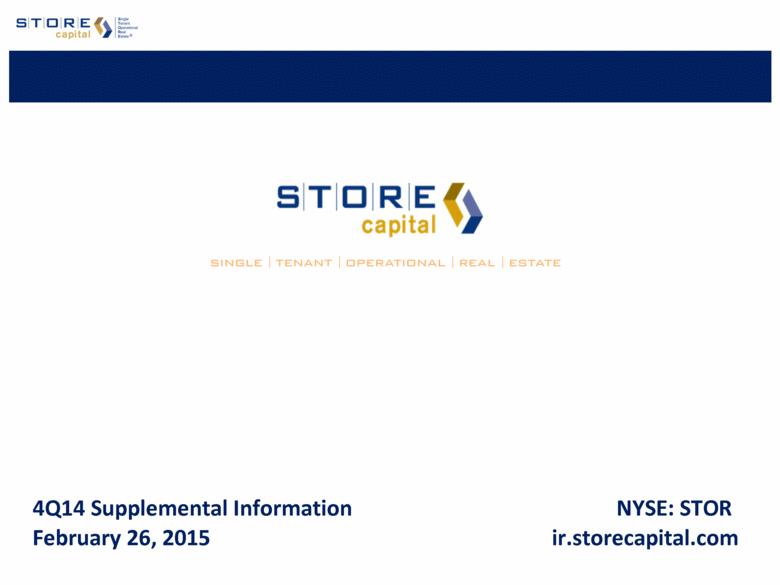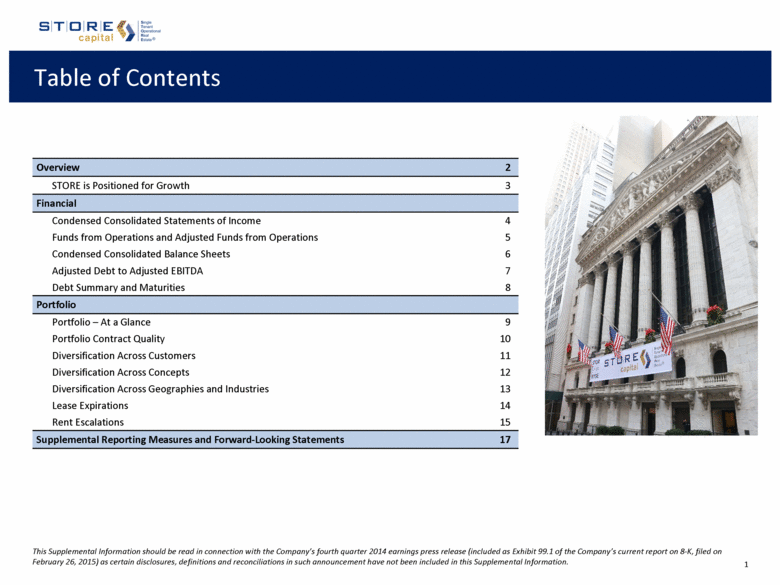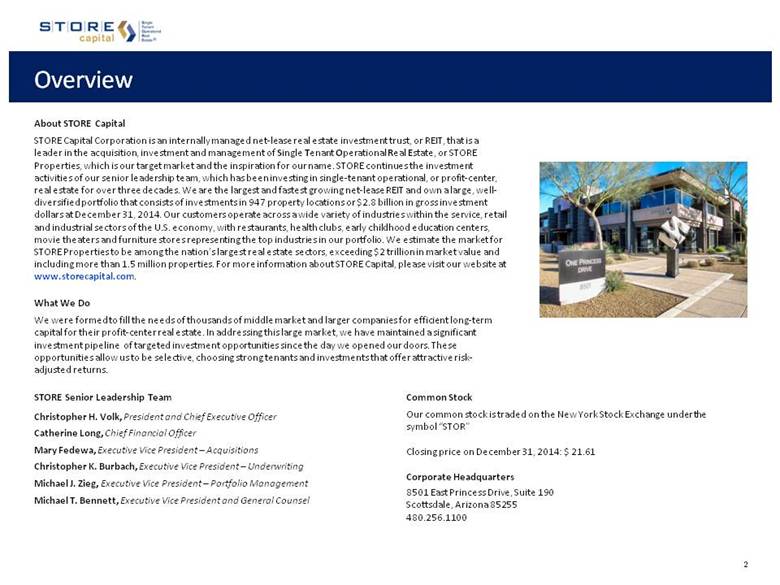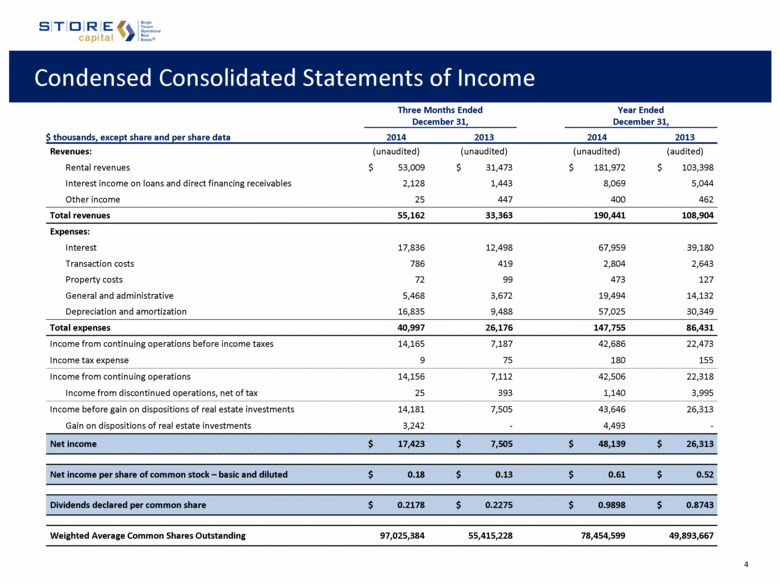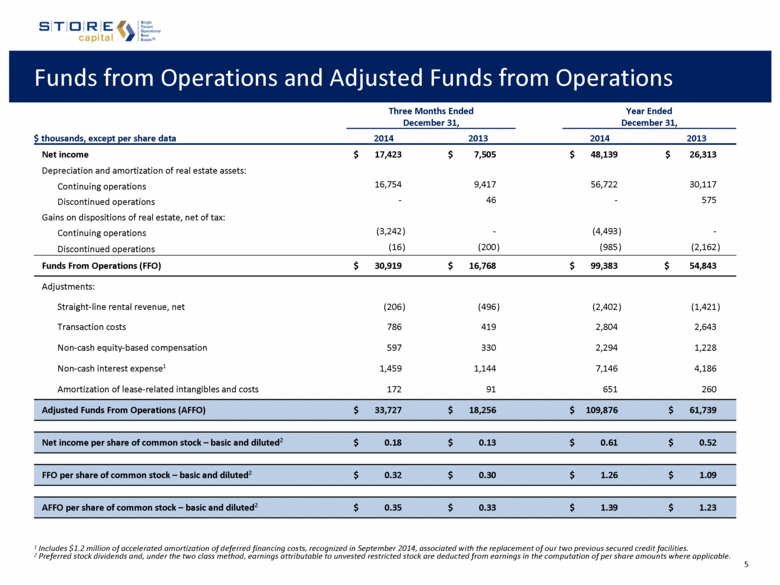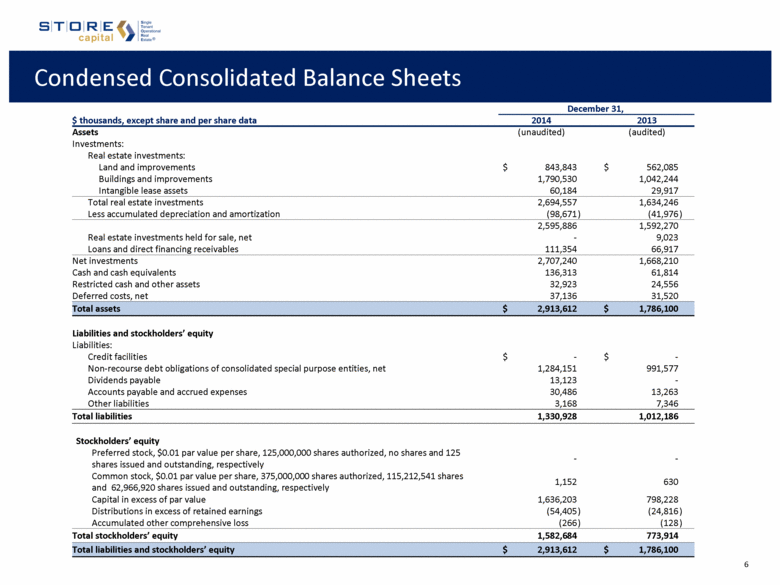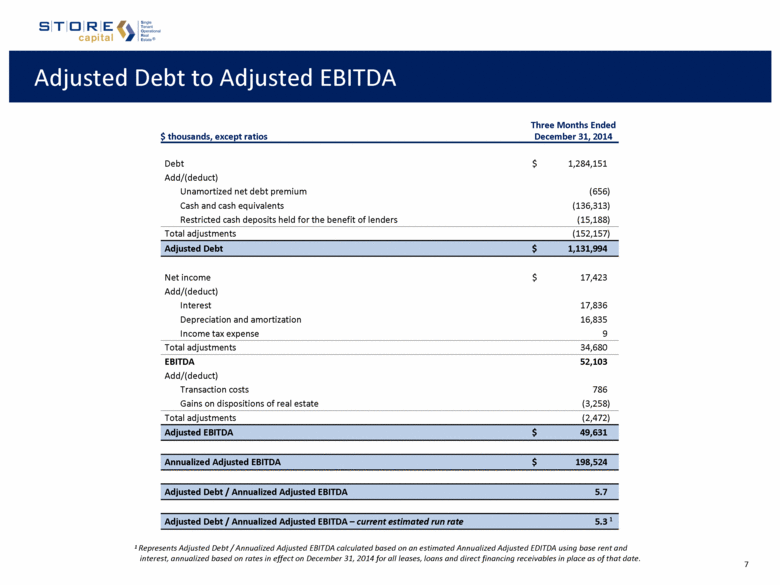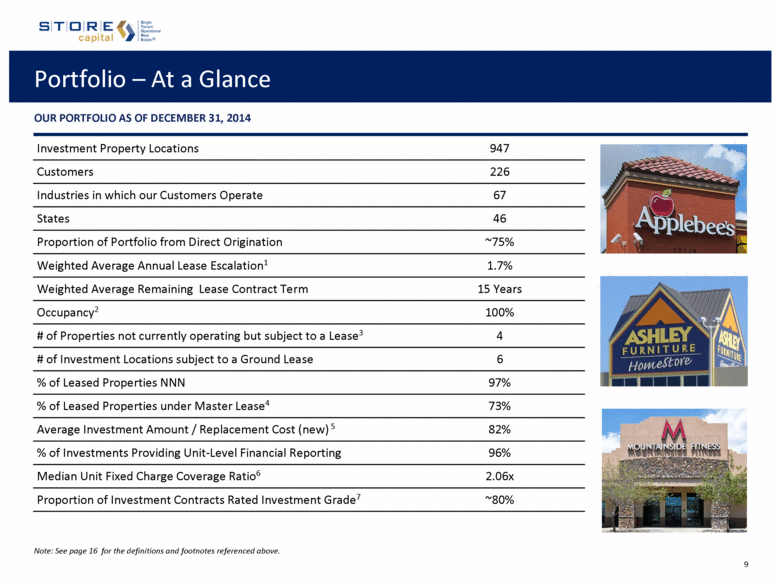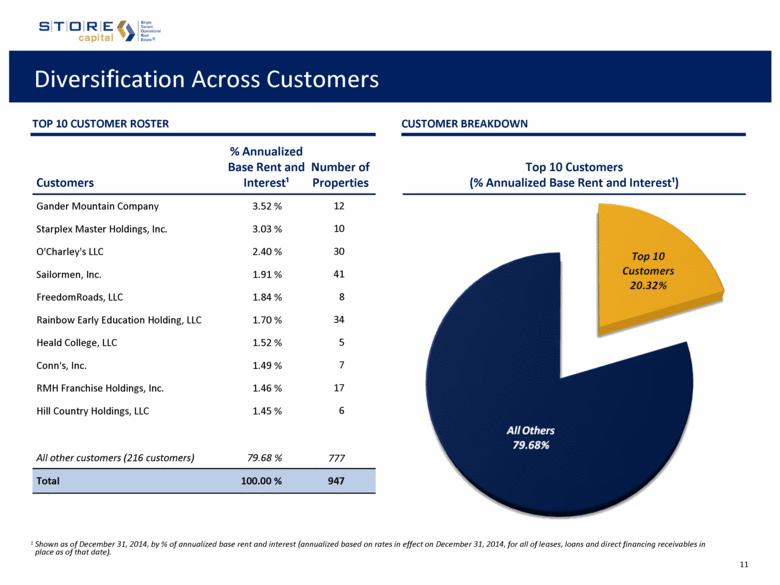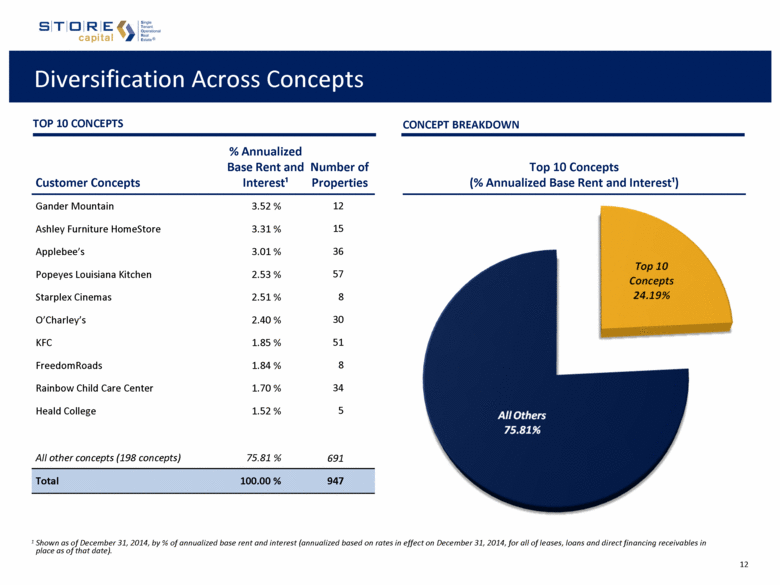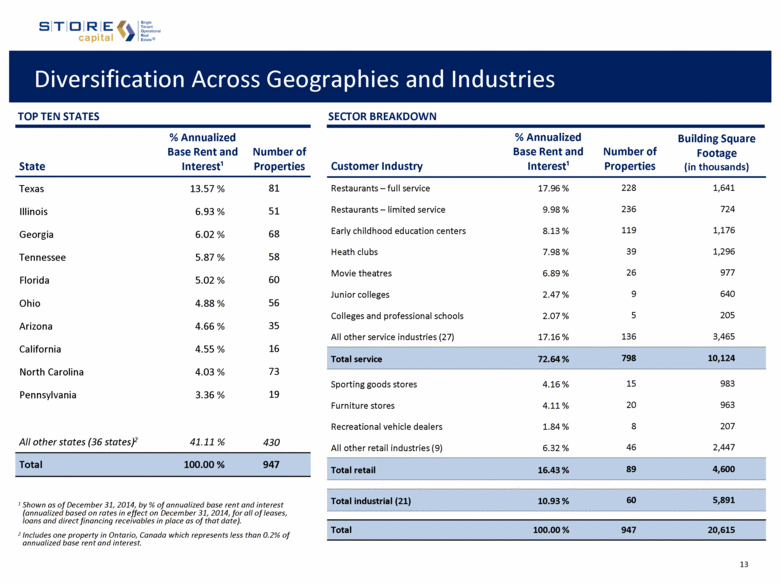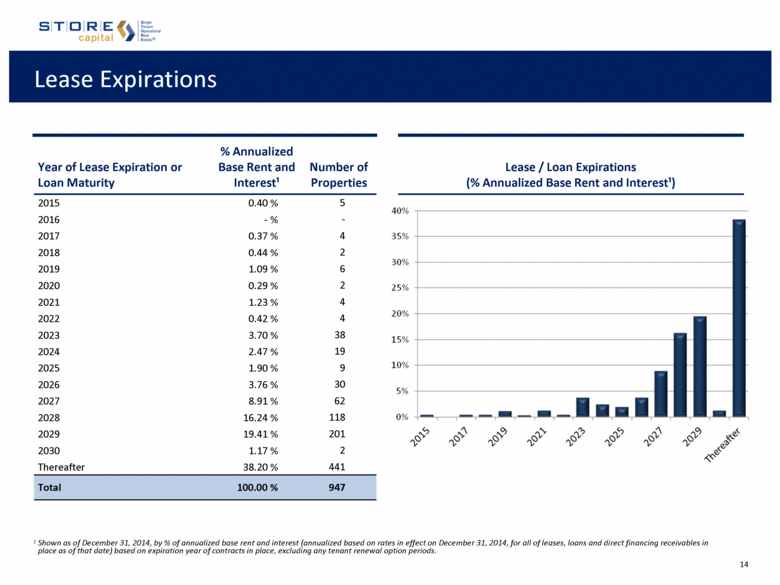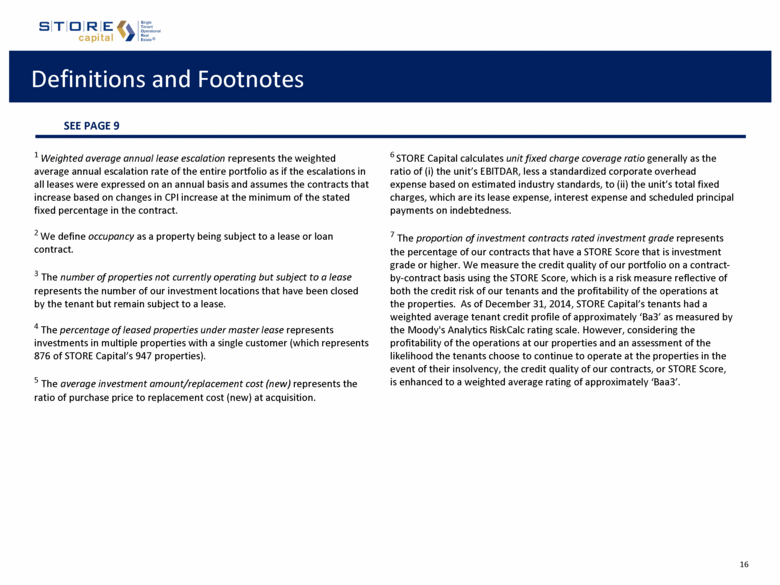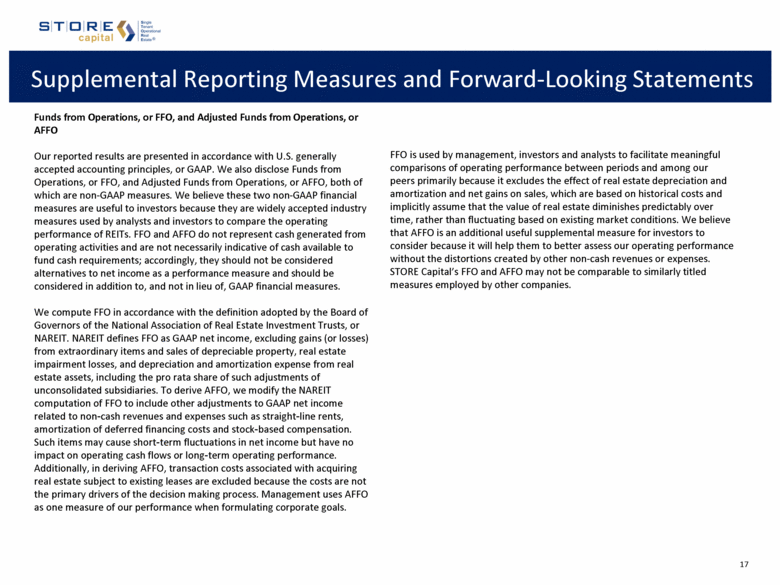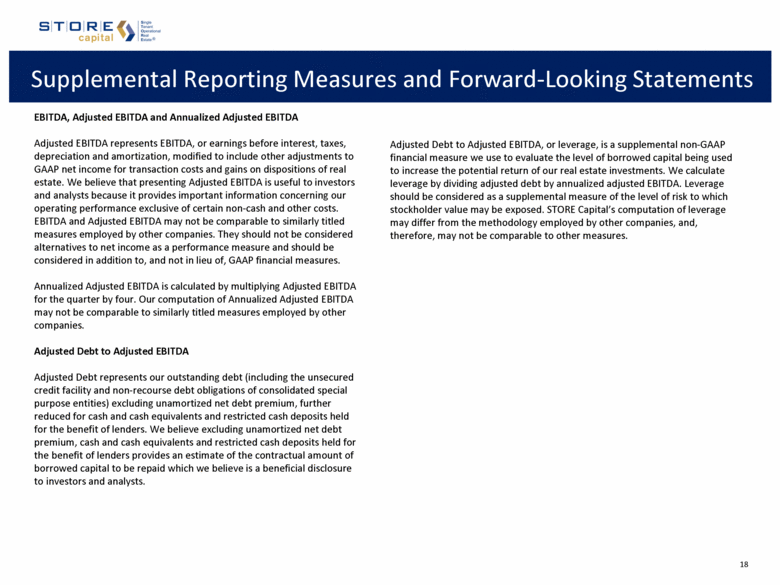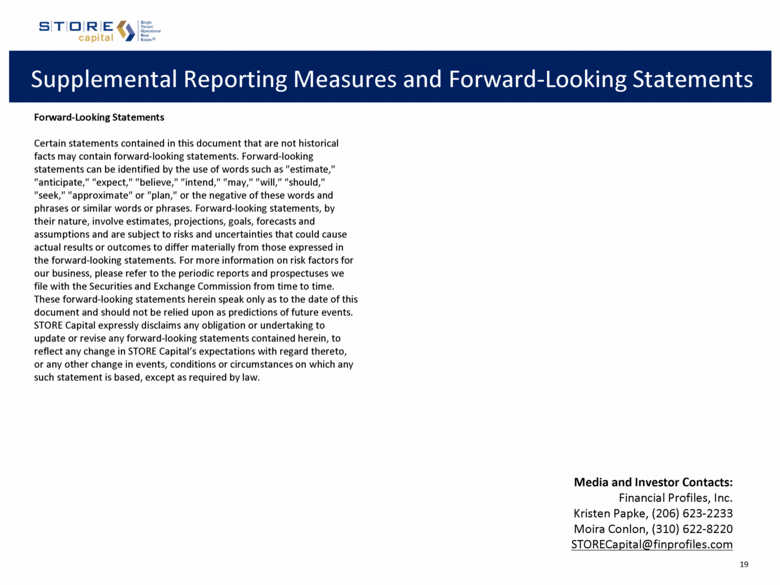Attached files
| file | filename |
|---|---|
| 8-K - 8-K - STORE CAPITAL Corp | a15-5352_18k.htm |
| EX-99.1 - EX-99.1 - STORE CAPITAL Corp | a15-5352_1ex99d1.htm |
Exhibit 99.2
|
|
4Q14 Supplemental Information NYSE: STOR February 26, 2015 ir.storecapital.com |
|
|
Table of Contents This Supplemental Information should be read in connection with the Company’s fourth quarter 2014 earnings press release (included as Exhibit 99.1 of the Company’s current report on 8-K, filed on February 26, 2015) as certain disclosures, definitions and reconciliations in such announcement have not been included in this Supplemental Information. Overview 2 STORE is Positioned for Growth 3 Financial Condensed Consolidated Statements of Income 4 Funds from Operations and Adjusted Funds from Operations 5 Condensed Consolidated Balance Sheets 6 Adjusted Debt to Adjusted EBITDA 7 Debt Summary and Maturities 8 Portfolio Portfolio – At a Glance 9 Portfolio Contract Quality 10 Diversification Across Customers 11 Diversification Across Concepts 12 Diversification Across Geographies and Industries 13 Lease Expirations 14 Rent Escalations 15 Supplemental Reporting Measures and Forward-Looking Statements 17 |
|
|
Overview About STORE Capital STORE Capital Corporation is an internally managed net-lease real estate investment trust, or REIT, that is a leader in the acquisition, investment and management of Single Tenant Operational Real Estate, or STORE Properties, which is our target market and the inspiration for our name. STORE continues the investment activities of our senior leadership team, which has been investing in single-tenant operational, or profit-center, real estate for over three decades. We are the largest and fastest growing net-lease REIT and own a large, well-diversified portfolio that consists of investments in 947 property locations or $2.8 billion in gross investment dollars at December 31, 2014. Our customers operate across a wide variety of industries within the service, retail and industrial sectors of the U.S. economy, with restaurants, health clubs, early childhood education centers, movie theaters and furniture stores representing the top industries in our portfolio. We estimate the market for STORE Properties to be among the nation’s largest real estate sectors, exceeding $2 trillion in market value and including more than 1.5 million properties. For more information about STORE Capital, please visit our website at www.storecapital.com. Common Stock Our common stock is traded on the New York Stock Exchange under the symbol “STOR” Closing price on December 31, 2014: $ 21.61 Corporate Headquarters 8501 East Princess Drive, Suite 190 Scottsdale, Arizona 85255 480.256.1100 STORE Senior Leadership Team Christopher H. Volk, President and Chief Executive Officer Catherine Long, Chief Financial Officer Mary Fedewa, Executive Vice President – Acquisitions Christopher K. Burbach, Executive Vice President – Underwriting Michael J. Zieg, Executive Vice President – Portfolio Management Michael T. Bennett, Executive Vice President and General Counsel What We Do We were formed to fill the needs of thousands of middle market and larger companies for efficient long-term capital for their profit-center real estate. In addressing this large market, we have maintained a significant investment pipeline of targeted investment opportunities since the day we opened our doors. These opportunities allow us to be selective, choosing strong tenants and investments that offer attractive risk-adjusted returns. |
|
|
STORE is Positioned for Growth The market for STORE Properties exceeds $2 trillion in market value and includes more than 1.5 million properties. Despite the market's size, the financing marketplace for STORE Properties is highly fragmented, with few participants addressing the long-term capital needs of middle market and larger nonrated companies. TOTAL TARGET MARKET SIZE ($2.3 TRILLION) KEY GROWTH DRIVERS We Create Demand We create stockholder value through more than real estate aggregation. We originate approximately 75% of our real estate investments through direct tenant relationships which offer both our tenants and investors superior value. We are Scalable in our Operations As we grow, we expect the cost to manage our portfolio to decline as a percentage of investment value. We built STORE with highly efficient systems to enable this operating leverage. We Have an Efficient Capital Structure Our A+ rated long-term debt conduit, STORE Master Funding, short-term unsecured borrowings and approximately $1 billion in unencumbered assets provide us with access to long-term, low-cost capital. MARKET OVERVIEW |
|
|
Condensed Consolidated Statements of Income Three Months Ended December 31, Year Ended December 31, $ thousands, except share and per share data 2014 2013 2014 2013 Revenues: (unaudited) (unaudited) (unaudited) (audited) Rental revenues $ 53,009 $ 31,473 $ 181,972 $ 103,398 Interest income on loans and direct financing receivables 2,128 1,443 8,069 5,044 Other income 25 447 400 462 Total revenues 55,162 33,363 190,441 108,904 Expenses: Interest 17,836 12,498 67,959 39,180 Transaction costs 786 419 2,804 2,643 Property costs 72 99 473 127 General and administrative 5,468 3,672 19,494 14,132 Depreciation and amortization 16,835 9,488 57,025 30,349 Total expenses 40,997 26,176 147,755 86,431 Income from continuing operations before income taxes 14,165 7,187 42,686 22,473 Income tax expense 9 75 180 155 Income from continuing operations 14,156 7,112 42,506 22,318 Income from discontinued operations, net of tax 25 393 1,140 3,995 Income before gain on dispositions of real estate investments 14,181 7,505 43,646 26,313 Gain on dispositions of real estate investments 3,242 - 4,493 - Net income $ 17,423 $ 7,505 $ 48,139 $ 26,313 Net income per share of common stock – basic and diluted $ 0.18 $ 0.13 $ 0.61 $ 0.52 Dividends declared per common share $ 0.2178 $ 0.2275 $ 0.9898 $ 0.8743 Weighted Average Common Shares Outstanding 97,025,384 55,415,228 78,454,599 49,893,667 |
|
|
Funds from Operations and Adjusted Funds from Operations Three Months Ended December 31, Year Ended December 31, $ thousands, except per share data 2014 2013 2014 2013 Net income $ 17,423 $ 7,505 $ 48,139 $ 26,313 Depreciation and amortization of real estate assets: Continuing operations 16,754 9,417 56,722 30,117 Discontinued operations - 46 - 575 Gains on dispositions of real estate, net of tax: Continuing operations (3,242 ) - (4,493 ) - Discontinued operations (16 ) (200 ) (985 ) (2,162 ) Funds From Operations (FFO) $ 30,919 $ 16,768 $ 99,383 $ 54,843 Adjustments: Straight-line rental revenue, net (206 ) (496 ) (2,402 ) (1,421 ) Transaction costs 786 419 2,804 2,643 Non-cash equity-based compensation 597 330 2,294 1,228 Non-cash interest expense1 1,459 1,144 7,146 4,186 Amortization of lease-related intangibles and costs 172 91 651 260 Adjusted Funds From Operations (AFFO) $ 33,727 $ 18,256 $ 109,876 $ 61,739 Net income per share of common stock – basic and diluted2 $ 0.18 $ 0.13 $ 0.61 $ 0.52 FFO per share of common stock – basic and diluted2 $ 0.32 $ 0.30 $ 1.26 $ 1.09 AFFO per share of common stock – basic and diluted2 $ 0.35 $ 0.33 $ 1.39 $ 1.23 1 Includes $1.2 million of accelerated amortization of deferred financing costs, recognized in September 2014, associated with the replacement of our two previous secured credit facilities. 2 Preferred stock dividends and, under the two class method, earnings attributable to unvested restricted stock are deducted from earnings in the computation of per share amounts where applicable. |
|
|
Condensed Consolidated Balance Sheets December 31, $ thousands, except share and per share data 2014 2013 Assets (unaudited) (audited) Investments: Real estate investments: Land and improvements $ 843,843 $ 562,085 Buildings and improvements 1,790,530 1,042,244 Intangible lease assets 60,184 29,917 Total real estate investments 2,694,557 1,634,246 Less accumulated depreciation and amortization (98,671 ) (41,976 ) 2,595,886 1,592,270 Real estate investments held for sale, net - 9,023 Loans and direct financing receivables 111,354 66,917 Net investments 2,707,240 1,668,210 Cash and cash equivalents 136,313 61,814 Restricted cash and other assets 32,923 24,556 Deferred costs, net 37,136 31,520 Total assets $ 2,913,612 $ 1,786,100 Liabilities and stockholders’ equity Liabilities: Credit facilities $ - $ - Non-recourse debt obligations of consolidated special purpose entities, net 1,284,151 991,577 Dividends payable 13,123 - Accounts payable and accrued expenses 30,486 13,263 Other liabilities 3,168 7,346 Total liabilities 1,330,928 1,012,186 Stockholders’ equity Preferred stock, $0.01 par value per share, 125,000,000 shares authorized, no shares and 125 shares issued and outstanding, respectively - - Common stock, $0.01 par value per share, 375,000,000 shares authorized, 115,212,541 shares and 62,966,920 shares issued and outstanding, respectively 1,152 630 Capital in excess of par value 1,636,203 798,228 Distributions in excess of retained earnings (54,405 ) (24,816 ) Accumulated other comprehensive loss (266 ) (128 ) Total stockholders’ equity 1,582,684 773,914 Total liabilities and stockholders’ equity $ 2,913,612 $ 1,786,100 |
|
|
Adjusted Debt to Adjusted EBITDA $ thousands, except ratios Three Months Ended December 31, 2014 Debt $ 1,284,151 Add/(deduct) Unamortized net debt premium (656 ) Cash and cash equivalents (136,313 ) Restricted cash deposits held for the benefit of lenders (15,188 ) Total adjustments (152,157 ) Adjusted Debt $ 1,131,994 Net income $ 17,423 Add/(deduct) Interest 17,836 Depreciation and amortization 16,835 Income tax expense 9 Total adjustments 34,680 EBITDA 52,103 Add/(deduct) Transaction costs 786 Gains on dispositions of real estate (3,258 ) Total adjustments (2,472 ) Adjusted EBITDA $ 49,631 Annualized Adjusted EBITDA $ 198,524 Adjusted Debt / Annualized Adjusted EBITDA 5.7 Adjusted Debt / Annualized Adjusted EBITDA – current estimated run rate 5.3 1 1 Represents Adjusted Debt / Annualized Adjusted EBITDA calculated based on an estimated Annualized Adjusted EDITDA using base rent and interest, annualized based on rates in effect on December 31, 2014 for all leases, loans and direct financing receivables in place as of that date. |
|
|
Debt Summary and Maturities DEBT MATURITIES $ millions Weighted Average Interest Rate Expiration/ Maturity Date Outstanding Borrowings Gross Investment Amount of Collateral $300MM unsecured credit facility LIBOR + spread Sept 2017 $ - $ - Total short-term debt - - STORE Master Funding net-lease mortgage notes payable 4.85% 2019 to 2024 1,085 1,527 Other mortgage notes payable 5.12% 2015 to 2038 198 327 Total long-term debt 4.89% 1,283 1,854 Unencumbered real estate assets 952 Totals $ 1,283 $ 2,806 DEBT SUMMARY We seek to employ leverage judiciously, using diverse sources of fixed-rate, long-term financing. We are one of the few REITs to have an A+ rated borrowing capacity, which we define to mean either a corporate credit rating of A+ or higher from a nationally recognized rating agency or a securitization vehicle, or conduit, through which A+ or higher-rated debt securities are issued. Our largest borrowing source is our private conduit program, STORE Master Funding. The flexibility of STORE Master Funding enables us to better offer our customers tailored lease solutions, which we call Master Funding Solutions. PROVEN BORROWING STRATEGIES |
|
|
Portfolio – At a Glance OUR PORTFOLIO AS OF DECEMBER 31, 2014 Investment Property Locations 947 Customers 226 Industries in which our Customers Operate 67 States 46 Proportion of Portfolio from Direct Origination ~75% Weighted Average Annual Lease Escalation1 1.7% Weighted Average Remaining Lease Contract Term 15 Years Occupancy2 100% # of Properties not currently operating but subject to a Lease3 4 # of Investment Locations subject to a Ground Lease 6 % of Leased Properties NNN 97% % of Leased Properties under Master Lease4 73% Average Investment Amount / Replacement Cost (new) 5 82% % of Investments Providing Unit-Level Financial Reporting 96% Median Unit Fixed Charge Coverage Ratio6 2.06x Proportion of Investment Contracts Rated Investment Grade7 ~80% Note: See page 16 for the definitions and footnotes referenced above. |
|
|
Portfolio Contract Quality EXPECTED DEFAULT FREQUENCY & STORE SCORE EQUIVALENT RATINGS Data as of December 31, 2014. We measure the credit quality of our portfolio on a contract-by-contract basis using the STORE Score which is a risk measure reflective of both the credit risk of our tenants and the profitability of the operations at our properties. As of December 31, 2014, STORE Capital’s tenants have a weighted average tenant credit profile of approximately ‘Ba3’ as measured by Moody's RiskCalc. However, considering the profitability of the operations at our properties and the likelihood the tenants will choose to continue to operate at our properties in the event of their insolvency, the credit quality of our contracts, or STORE Score, is enhanced to a weighted average of ‘Baa3’. The STORE Score is a quantitative measurement of contract risk computed by stringing together tenant credit quality and store closure probabilities. However, qualitative features can also impact investment risk, such as low property investment amounts, the presence of third party guarantors or other factors. Such qualitative factors may serve to further mitigate investment risk. Portfolio Weighted Average EDF (Tenant Risk): 1.70% (Ba3) Portfolio Weighted Average STORE Score (Contract Risk): 0.65% (Baa3) Median EDF Approximately 80% of Investments have STORE > (Baa3) Median STORE Score Data as of December 31, 2014 |
|
|
Customers % Annualized Base Rent and Interest¹ Number of Properties Gander Mountain Company 3.52 % 12 Starplex Master Holdings, Inc. 3.03 % 10 O'Charley's LLC 2.40 % 30 Sailormen, Inc. 1.91 % 41 FreedomRoads, LLC 1.84 % 8 Rainbow Early Education Holding, LLC 1.70 % 34 Heald College, LLC 1.52 % 5 Conn's, Inc. 1.49 % 7 RMH Franchise Holdings, Inc. 1.46 % 17 Hill Country Holdings, LLC 1.45 % 6 All other customers (216 customers) 79.68 % 777 Total 100.00 % 947 Diversification Across Customers 1 Shown as of December 31, 2014, by % of annualized base rent and interest (annualized based on rates in effect on December 31, 2014, for all of leases, loans and direct financing receivables in place as of that date). TOP 10 CUSTOMER ROSTER CUSTOMER BREAKDOWN Top 10 Customers (% Annualized Base Rent and Interest¹) Top 10 Customers 20.32% All Others 79.68% |
|
|
Customer Concepts % Annualized Base Rent and Interest¹ Number of Properties Gander Mountain 3.52 % 12 Ashley Furniture HomeStore 3.31 % 15 Applebee’s 3.01 % 36 Popeyes Louisiana Kitchen 2.53 % 57 Starplex Cinemas 2.51 % 8 O’Charley’s 2.40 % 30 KFC 1.85 % 51 FreedomRoads 1.84 % 8 Rainbow Child Care Center 1.70 % 34 Heald College 1.52 % 5 All other concepts (198 concepts) 75.81 % 691 Total 100.00 % 947 Diversification Across Concepts 1 Shown as of December 31, 2014, by % of annualized base rent and interest (annualized based on rates in effect on December 31, 2014, for all of leases, loans and direct financing receivables in place as of that date). TOP 10 CONCEPTS CONCEPT BREAKDOWN Top 10 Concepts (% Annualized Base Rent and Interest¹) Top 10 Concepts 24.19% All Others 75.81% |
|
|
State % Annualized Base Rent and Interest¹ Number of Properties Texas 13.57 % 81 Illinois 6.93 % 51 Georgia 6.02 % 68 Tennessee 5.87 % 58 Florida 5.02 % 60 Ohio 4.88 % 56 Arizona 4.66 % 35 California 4.55 % 16 North Carolina 4.03 % 73 Pennsylvania 3.36 % 19 All other states (36 states)2 41.11 % 430 Total 100.00 % 947 Diversification Across Geographies and Industries 1 Shown as of December 31, 2014, by % of annualized base rent and interest (annualized based on rates in effect on December 31, 2014, for all of leases, loans and direct financing receivables in place as of that date). 2 Includes one property in Ontario, Canada which represents less than 0.2% of annualized base rent and interest. TOP TEN STATES SECTOR BREAKDOWN Customer Industry % Annualized Base Rent and Interest¹ Number of Properties Building Square Footage (in thousands) Restaurants – full service 17.96 % 228 1,641 Restaurants – limited service 9.98 % 236 724 Early childhood education centers 8.13 % 119 1,176 Heath clubs 7.98 % 39 1,296 Movie theatres 6.89 % 26 977 Junior colleges 2.47 % 9 640 Colleges and professional schools 2.07 % 5 205 All other service industries (27) 17.16 % 136 3,465 Total service 72.64 % 798 10,124 Sporting goods stores 4.16 % 15 983 Furniture stores 4.11 % 20 963 Recreational vehicle dealers 1.84 % 8 207 All other retail industries (9) 6.32 % 46 2,447 Total retail 16.43 % 89 4,600 Total industrial (21) 10.93 % 60 5,891 Total 100.00 % 947 20,615 |
|
|
Year of Lease Expiration or Loan Maturity % Annualized Base Rent and Interest¹ Number of Properties 2015 0.40 % 5 2016 - % - 2017 0.37 % 4 2018 0.44 % 2 2019 1.09 % 6 2020 0.29 % 2 2021 1.23 % 4 2022 0.42 % 4 2023 3.70 % 38 2024 2.47 % 19 2025 1.90 % 9 2026 3.76 % 30 2027 8.91 % 62 2028 16.24 % 118 2029 19.41 % 201 2030 1.17 % 2 Thereafter 38.20 % 441 Total 100.00 % 947 Lease Expirations 1 Shown as of December 31, 2014, by % of annualized base rent and interest (annualized based on rates in effect on December 31, 2014, for all of leases, loans and direct financing receivables in place as of that date) based on expiration year of contracts in place, excluding any tenant renewal option periods. Lease / Loan Expirations (% Annualized Base Rent and Interest¹) |
|
|
Rent Escalations 1 Shown as of December 31, 2014, by % of annualized base rent and interest (annualized based on rates in effect on December 31, 2014, for all of leases, loans and direct financing receivables in place as of that date). Lease Escalation Frequency % Annualized Base Rent and Interest¹ Weighted Average Annual Escalation Rate Annually 63 % 1.8 % Every 2 years 1 % 0.5 % Every 3 years 2 % 2.1 % Every 5 years 30 % 1.7 % Every 10 years 1 % 1.0 % Other 3 % NA Total / Weighted Average 100 % 1.7 % At December 31, 2014, approximately 63% of our leases provided for annual escalations. We believe such frequent escalations are unusual in the net lease real estate auction marketplace, where escalations are not uncommon, but are usually less frequent. The majority of the remainder of our leases generally provided for payment escalation every five years. As of December 31, 2014, the weighted average annual escalation rate of our entire portfolio was 1.7% (if the escalations in all of our leases are expressed on an annual basis and assuming the contracts that increase based on CPI increase at the minimum of the stated contractual fixed percentage in the contract). FREQUENT RENT ESCALATIONS PROVIDE A MEASURE OF INFLATION PROTECTION AND A STRONG POTENTIAL SOURCE OF INTERNAL GROWTH Contractual Fixed 22.8% Contractual CPI-Based 73.7% |
|
|
Definitions and Footnotes 1 Weighted average annual lease escalation represents the weighted average annual escalation rate of the entire portfolio as if the escalations in all leases were expressed on an annual basis and assumes the contracts that increase based on changes in CPI increase at the minimum of the stated fixed percentage in the contract. 2 We define occupancy as a property being subject to a lease or loan contract. 3 The number of properties not currently operating but subject to a lease represents the number of our investment locations that have been closed by the tenant but remain subject to a lease. 4 The percentage of leased properties under master lease represents investments in multiple properties with a single customer (which represents 876 of STORE Capital’s 947 properties). 5 The average investment amount/replacement cost (new) represents the ratio of purchase price to replacement cost (new) at acquisition. 6 STORE Capital calculates unit fixed charge coverage ratio generally as the ratio of (i) the unit’s EBITDAR, less a standardized corporate overhead expense based on estimated industry standards, to (ii) the unit’s total fixed charges, which are its lease expense, interest expense and scheduled principal payments on indebtedness. 7 The proportion of investment contracts rated investment grade represents the percentage of our contracts that have a STORE Score that is investment grade or higher. We measure the credit quality of our portfolio on a contract-by-contract basis using the STORE Score, which is a risk measure reflective of both the credit risk of our tenants and the profitability of the operations at the properties. As of December 31, 2014, STORE Capital’s tenants had a weighted average tenant credit profile of approximately ‘Ba3’ as measured by the Moody's Analytics RiskCalc rating scale. However, considering the profitability of the operations at our properties and an assessment of the likelihood the tenants choose to continue to operate at the properties in the event of their insolvency, the credit quality of our contracts, or STORE Score, is enhanced to a weighted average rating of approximately ‘Baa3’. SEE PAGE 9 |
|
|
Supplemental Reporting Measures and Forward-Looking Statements Funds from Operations, or FFO, and Adjusted Funds from Operations, or AFFO Our reported results are presented in accordance with U.S. generally accepted accounting principles, or GAAP. We also disclose Funds from Operations, or FFO, and Adjusted Funds from Operations, or AFFO, both of which are non-GAAP measures. We believe these two non-GAAP financial measures are useful to investors because they are widely accepted industry measures used by analysts and investors to compare the operating performance of REITs. FFO and AFFO do not represent cash generated from operating activities and are not necessarily indicative of cash available to fund cash requirements; accordingly, they should not be considered alternatives to net income as a performance measure and should be considered in addition to, and not in lieu of, GAAP financial measures. We compute FFO in accordance with the definition adopted by the Board of Governors of the National Association of Real Estate Investment Trusts, or NAREIT. NAREIT defines FFO as GAAP net income, excluding gains (or losses) from extraordinary items and sales of depreciable property, real estate impairment losses, and depreciation and amortization expense from real estate assets, including the pro rata share of such adjustments of unconsolidated subsidiaries. To derive AFFO, we modify the NAREIT computation of FFO to include other adjustments to GAAP net income related to non-cash revenues and expenses such as straight-line rents, amortization of deferred financing costs and stock-based compensation. Such items may cause short-term fluctuations in net income but have no impact on operating cash flows or long-term operating performance. Additionally, in deriving AFFO, transaction costs associated with acquiring real estate subject to existing leases are excluded because the costs are not the primary drivers of the decision making process. Management uses AFFO as one measure of our performance when formulating corporate goals. FFO is used by management, investors and analysts to facilitate meaningful comparisons of operating performance between periods and among our peers primarily because it excludes the effect of real estate depreciation and amortization and net gains on sales, which are based on historical costs and implicitly assume that the value of real estate diminishes predictably over time, rather than fluctuating based on existing market conditions. We believe that AFFO is an additional useful supplemental measure for investors to consider because it will help them to better assess our operating performance without the distortions created by other non-cash revenues or expenses. STORE Capital’s FFO and AFFO may not be comparable to similarly titled measures employed by other companies. |
|
|
Supplemental Reporting Measures and Forward-Looking Statements EBITDA, Adjusted EBITDA and Annualized Adjusted EBITDA Adjusted EBITDA represents EBITDA, or earnings before interest, taxes, depreciation and amortization, modified to include other adjustments to GAAP net income for transaction costs and gains on dispositions of real estate. We believe that presenting Adjusted EBITDA is useful to investors and analysts because it provides important information concerning our operating performance exclusive of certain non-cash and other costs. EBITDA and Adjusted EBITDA may not be comparable to similarly titled measures employed by other companies. They should not be considered alternatives to net income as a performance measure and should be considered in addition to, and not in lieu of, GAAP financial measures. Annualized Adjusted EBITDA is calculated by multiplying Adjusted EBITDA for the quarter by four. Our computation of Annualized Adjusted EBITDA may not be comparable to similarly titled measures employed by other companies. Adjusted Debt to Adjusted EBITDA Adjusted Debt represents our outstanding debt (including the unsecured credit facility and non-recourse debt obligations of consolidated special purpose entities) excluding unamortized net debt premium, further reduced for cash and cash equivalents and restricted cash deposits held for the benefit of lenders. We believe excluding unamortized net debt premium, cash and cash equivalents and restricted cash deposits held for the benefit of lenders provides an estimate of the contractual amount of borrowed capital to be repaid which we believe is a beneficial disclosure to investors and analysts. Adjusted Debt to Adjusted EBITDA, or leverage, is a supplemental non-GAAP financial measure we use to evaluate the level of borrowed capital being used to increase the potential return of our real estate investments. We calculate leverage by dividing adjusted debt by annualized adjusted EBITDA. Leverage should be considered as a supplemental measure of the level of risk to which stockholder value may be exposed. STORE Capital’s computation of leverage may differ from the methodology employed by other companies, and, therefore, may not be comparable to other measures. |
|
|
Supplemental Reporting Measures and Forward-Looking Statements Forward-Looking Statements Certain statements contained in this document that are not historical facts may contain forward-looking statements. Forward-looking statements can be identified by the use of words such as "estimate," "anticipate," "expect," "believe," "intend," "may," "will," "should," "seek," "approximate" or "plan," or the negative of these words and phrases or similar words or phrases. Forward-looking statements, by their nature, involve estimates, projections, goals, forecasts and assumptions and are subject to risks and uncertainties that could cause actual results or outcomes to differ materially from those expressed in the forward-looking statements. For more information on risk factors for our business, please refer to the periodic reports and prospectuses we file with the Securities and Exchange Commission from time to time. These forward-looking statements herein speak only as to the date of this document and should not be relied upon as predictions of future events. STORE Capital expressly disclaims any obligation or undertaking to update or revise any forward-looking statements contained herein, to reflect any change in STORE Capital’s expectations with regard thereto, or any other change in events, conditions or circumstances on which any such statement is based, except as required by law. Media and Investor Contacts: Financial Profiles, Inc. Kristen Papke, (206) 623-2233 Moira Conlon, (310) 622-8220 STORECapital@finprofiles.com |

